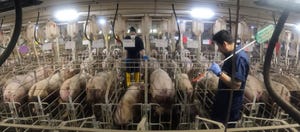USDA forecasts ‘very, very small growth’ for U.S. meat and poultry
Outlook suggests contrasting pictures for beef and pork, mixed bag for poultry.

Total U.S. meat and poultry production is forecast only fractionally higher in 2024 — up just 0.1% to 107 billion pounds — as each commodity faces its own set of challenges.
Lower feed costs, more hay and diminishing drought in some areas have failed to incentivize the U.S. beef cattle sector to start rebuilding. Giving an overview of the livestock and poultry outlook at the 2024 USDA Agricultural Outlook Forum, U.S. Department of Agriculture livestock economist Shayle Shagam said a couple of factors are at play.
The first factor is record-high feeder calf prices, he suggested.
“It may be profitable to take the money right now, especially if you’re having to pay off high feed bills of the previous years. You also have relatively high interest rates,” he said.
With a “guaranteed sure thing” in relatively high feeder cattle prices, Shagam said producers are likely opting out of holding animals for several years until they can generate a calf.
Obviously, another important factor to look at is U.S. hay stocks. Even in areas where the drought situation is improving, hay stocks are still lower than historical norms, Shagam noted. Producers may be weighing herd contraction or expansion based upon scenarios of whether the drought improves or worsens this year.
For now, “the bottom line is that the beef cow herd is getting smaller,” he said.
The outlook for total number of cattle in feedlots is down about 0.2%. Of those animals, Shagam said 1.6% are already in the feedlots. “That leaves about 4% fewer animals to be placed during the course of the year.”
A lot of those animals that are already in feedlots will be coming out in the first part of the year. Animals that are currently outside of feedlots will likely be placed during the first half of this year and then will be coming out in the second half.
“With those tightening supplies of cattle outside of feedlots, feeder calves are going to be very valuable. You have to have something to put in those feedlots,” Shagam said, adding that prices this year will likely reach $248.00-$249.00/cwt. for a 750-800 pound feeder steer, which compares to the record last year of $219.00/cwt.
USDA is forecasting 2024 beef production to be 3% lower than 2023, at 26.2 billion pounds.
In the hog sector, production is expected to rise by 2%, “which seems a little counterintuitive” given the state of the industry, Shagam said. However, he noted that it takes a little while to “turn the ship.”
Hog inventory rose to 75 million head on Dec. 1, 2023. That number is expected to decline over time, “but it’s going to take us a while to get to that lower expected inventory by the end of the year,” he explained.
Returns for farrow-to-finish operators were negative for most of last year. As such, retrenchment would be expected, Shagam said.
Farrowings were down roughly 3.5% during the second half of 2023. This number is expected to be down 1-2% during the first half of 2024, and an even “stronger retrenchment” is expected during the second half of 2024, with farrowings probably around 2.5-3.0% lower.
However, growth in pigs per litter is partially offsetting this, Shagam pointed out. “Up until COVID, things were moving along at a fairly good clip. Then all of the sudden COVID came along, and the couple years after COVID, the rate of growth in pigs per litter diminished.”
Within the past couple of quarters, things have started to move back up to where they had been pre-COVID, and USDA anticipates pigs per litter will rise 2% in 2024.
Shagam further stated that right-sizing the breeding herd may have started to occur, as sow and boar slaughter has increased over the past two weeks. However, he questioned whether this drop is due to winter weather in January or if it is actually a sign of things to come.
Poultry a mixed bag
USDA is forecasting broiler production to rise about 1% in 2024. Improved returns seen during the second half of 2023 are expected to continue due to support from higher broiler prices and lower feed costs during 2024, Shagam said. The broiler laying flock is gradually rebuilding, with an approximately 1% rise seen in January.
Despite these factors, he said the current expansion will be limited. “I think producers are being very cautious in their expansion.”
Pullet levels are close to historical norms, which would indicate that producers are not in a big push to expand laying flocks.
Broiler chick placements are “pretty close to prior years,” Shagam noted. The industry is balancing available supply with what they believe demand will be.
The turkey industry, on the other hand, has been “facing multiple challenges in the past year,” Shagam said. Losses due to highly pathogenic avian influenza (HPAI) reduced the flock, but there was also weak demand. “The prices have been weak, and they’ve really been outweighing lower feed prices.”
Turkey prices for 2023 as a whole were down only about 12%, but a counter-seasonal trend led to a 50% decline from the first week of January 2023 to the last week of December 2023. Prices are starting to climb again, but returns have sharply declined because of the lower prices, which were too much to offset any declines in feed prices.
Bird numbers at the beginning of the year are about 9-10% below last year, some of which is due to the culling that occurred from HPAI. It may also be due to the industry going through a little bit of a retrenchment, Shagam added.
All of this means production during the first half of 2024 will be below the same period last year. A slow buildup will likely occur in the second half as prices improve, he said.
As for eggs, Shagam said it’s been “a little bit of a wild ride.” The flock is a little larger, but there were culls due to HPAI. There has been some supply help from eggs per layer, but as that flock ages, increases in eggs per layer will diminish. Only a very slight year-over-year increase is expected in egg production in 2024.
Egg prices have been volatile due to egg supply tightness and seasonal holiday demand. Pending no further HPAI outbreaks, Shagam said the volatility should diminish as inventory numbers stabilize. Egg prices are projected to average a bit lower this year at $1.83/doz.
About the Author(s)
You May Also Like





